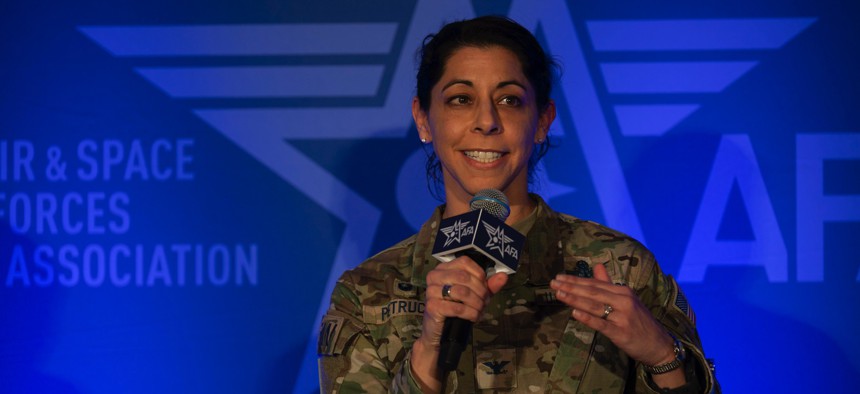
U.S. Space Force Col. Nicole Petrucci, commander of Space Delta 3 – Space Electromagnetic Warfare, shares her perspective on becoming an Integrated Mission Delta at the Air & Space Forces Association Warfare Symposium in Aurora, Colorado, Feb. 13, 2024. U.S. Space Force / John Ayer
Space Force units that operate and sustain their gear? Let’s make more, leader says
The months-old Integrated Mission Deltas for electromagnetic warfare and positioning-navigation-timing have already proven their value, Space Operations commander says.
Updated: 1:30 p.m. on March 1.
The Space Force is already seeing success from experimental units that put both operations and sustainment efforts for specific missions under a single leader—and is looking to bring it to other parts of the service, according to the new head of Space Operations Command.
“We are having conversations about that with the service chief. He will decide what are the next candidates to do that…You can imagine that my recommendations are pretty aggressive, but we’re going to go with whatever the service chief and the secretary decide and I think you’ll hear something about that in the coming weeks,” Lt. Gen. David Miller told reporters Feb. 27.
Chief of Space Operations Gen. Chance Saltzman announced in September that his service was launching a prototype effort to put operations, acquisition, and sustainment for certain missions under single team leaders—a departure from the current structure of the service, which splits these into different commands.
After this article was posted, a Space Force spokesman clarified that the new units would work with acquisition specialists on sustainment efforts but would not handle initial acquisition of capabilities.
The first two of these “Integrated Mission Deltas,” or IMDs, focus on electromagnetic warfare and positioning, navigation, and timing, or PNT.
These two new deltas have already produced efficiencies for the force, Miller said; the PNT delta has been able to “advance through milestones for testing at an unprecedented rate” and quickly fix outages with sustainment and maintenance under one commander.
This new structure ensures that a mission area commander has “all the assets they need to address a particular threat vector as well as a mission requirement that the joint force had,” he said.
But, Miller added, not all of SpOC’s deltas—the service’s equivalent to Air Force wings—need to become integrated deltas. This model is best for mission areas that require forces to be present to Space Command, not for deltas that are focused on providing a specific mission to the Space Force, he said.
“I just don’t think that in every case and in every situation that you’ll see IMD…be a requirement,” he said. “Some of those deltas don’t need that but they still need to be part of Space Operations Command. They just don’t necessarily need to be integrating all those capabilities under one single commander. In some cases, they’re providing resources that need to be service retained, and it’s not necessarily something that needs to be presented under a single mission area commander at the delta level.”
The command has sent its recommendations to Saltzman for the next mission areas that the service should scale this to.
“What’s coming next? That’s up to the secretary and the service chief. I will tell you that my recommendations are in,” Miller said.
Space Operations Command is in charge of organizing and training guardians and presenting them to Space Command and other combatant commands.
